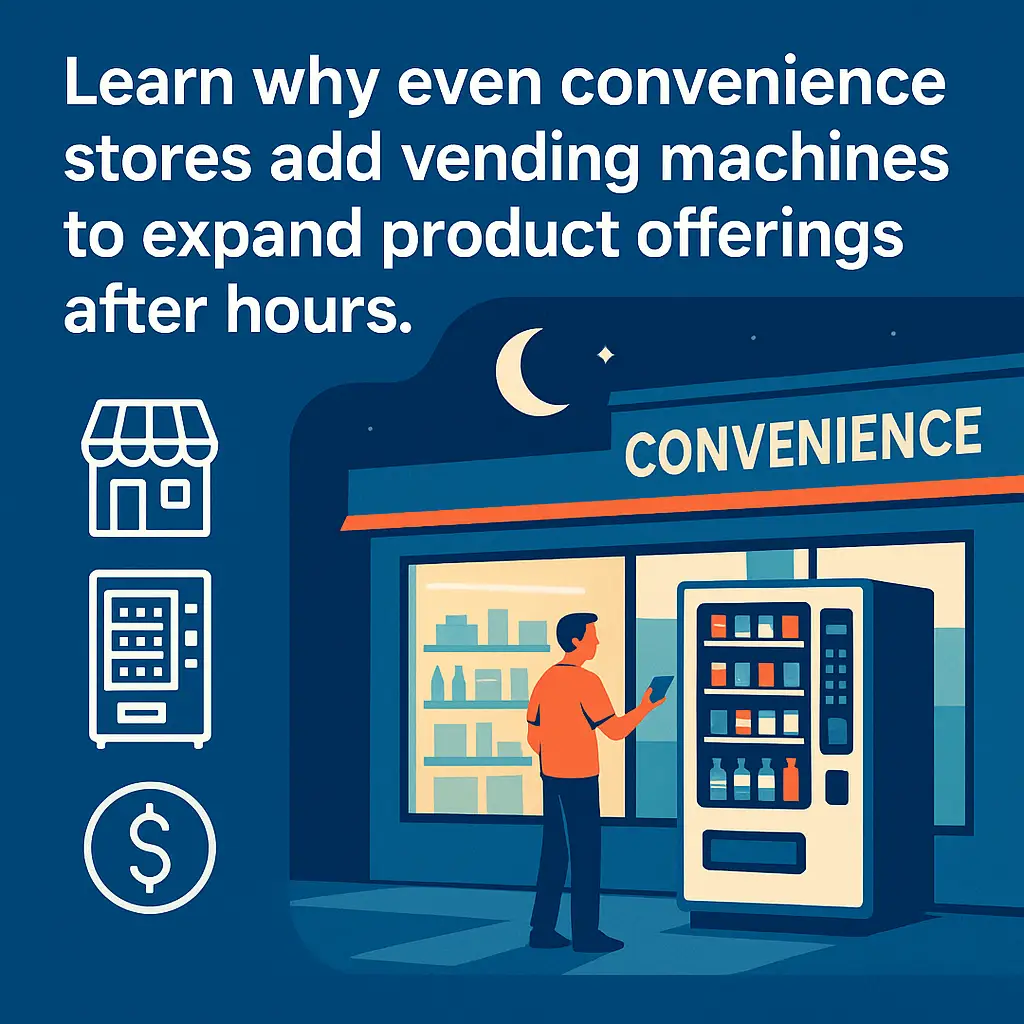Vending Machines in Convenience Stores
Learn why even convenience stores add vending machines to expand product offerings after hours.
Back to Vending for Retail Locations ResourcesLearn why even convenience stores add vending machines to expand product offerings after hours.
Back to Vending for Retail Locations ResourcesVending stations help stores extend product selection, serve late-night customers, and increase per-visit spend without adding extra checkout burden.
![]() Capture after-hours and impulse purchases to boost daily revenue
Capture after-hours and impulse purchases to boost daily revenue
![]() Offer grab-and-go snacks, drinks, and essentials for faster customer flow
Offer grab-and-go snacks, drinks, and essentials for faster customer flow
![]() Flexible placement lets you test locations and product mixes with minimal disruption
Flexible placement lets you test locations and product mixes with minimal disruption

Convenience stores rely on speed, selection, and availability. Vending machines extend those benefits by providing self-service access to popular items any time the store is open — and often beyond staffed hours. Small-footprint vending units let stores test new product mixes, reduce lost sales when registers are busy, and attract customers looking for quick essentials. For an overview of how full-service vending works and what to expect, see what full-service vending includes.
Compact vending units fit into end-caps, vestibules, or near high-traffic zones, adding options like energy drinks, single-serve meals, and personal-care items without a major remodel. If you want to explore the specific advantages for retail environments, check the resource on benefits of vending for retail locations.
Product selection should reflect peak shopping times and local demand. In many convenience stores, cold beverages, quick snacks, and ready-to-eat items perform well; some locations also benefit from nonfood essentials such as phone accessories or travel-size toiletries. Guidance on curating a profitable mix can be found in how to choose vending products for your store.
Cashless payments and contactless wallets increase completed transactions and reduce friction. Machines with clear front-glass displays and branded wraps boost visibility and help promote seasonal items or local specialties. For ideas on merchandising and customer engagement, review examples from other venue types in vending in entertainment venues.
Refrigerated and temperature-controlled vending units make it possible to offer perishable ready-to-eat products while maintaining safety standards. If you’re prioritizing healthier or temperature-sensitive options, see recommendations in the healthy vending guide for public facilities for adaptable strategies.
Vending installations are typically low-impact for store operations. Machines can be placed and activated quickly, and performance can be tracked to fine-tune product selection and placement. To explore more resources and case studies across formats and industries, visit our Resources hub.
Ready to test vending in your store? Fill out the short form on this page to get started and learn which setups and product strategies best fit your location.
They increase product availability and capture impulse purchases, especially during busy or late hours.
No. Machines operate autonomously; routine checks are simple and don’t typically add significant staff time.
Cold beverages, energy drinks, snack bars, sandwiches, and quick essentials like phone chargers often perform well.
Yes. Most modern machines support cashless and contactless payments, which increases completed sales.
Compact refrigerated vending units are designed for small footprints and can safely dispense perishable items.
Place machines in high-visibility areas with good foot traffic that do not block aisles—near entrances or adjacent to the checkout area work well.
Use well-constructed machines, keep them in sight of staff or cameras, and ensure the area is well-lit to deter tampering.
Some local health or business regulations may apply—check municipal requirements if you plan to offer regulated food items.
Many vending systems provide sales data and telemetry that make it easy to monitor sales trends and adjust offerings.
Installations are typically fast—often completed within days—so stores can begin selling new items and capturing additional revenue quickly.